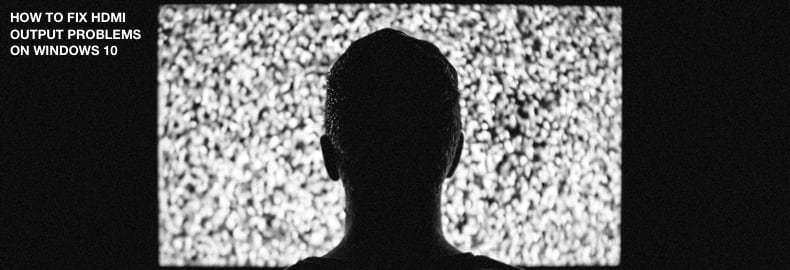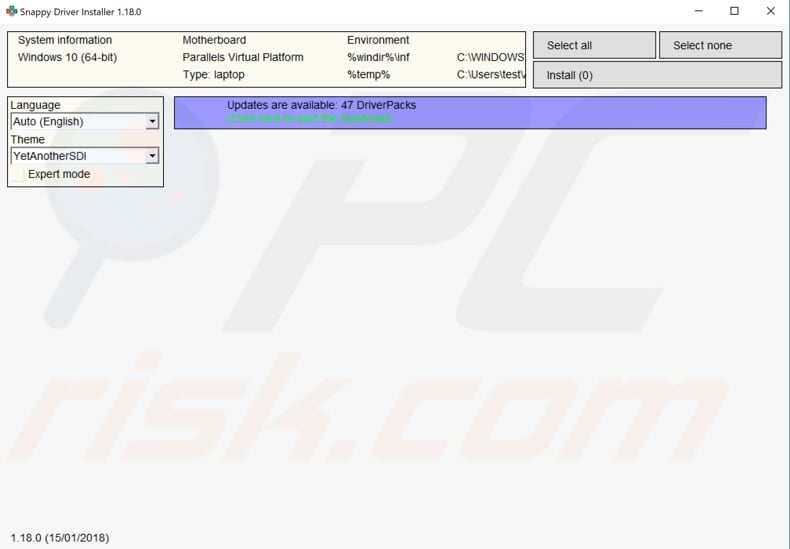How to Fix HDMI Output Problems?
Get Free Scanner and check your computer for errors
Fix It NowTo fix found issues, you have to purchase the full version of Combo Cleaner. Free trial available. Combo Cleaner is owned and operated by Rcs Lt, the parent company of PCRisk.com read more.
How to Fix HDMI Output Not Working and Other Problems on Windows 10?
HDMI (High-Definition Multimedia Interface) is an audio/video interface for transmitting uncompressed video data and compressed (or uncompressed) digital audio data from HDMI-compliant source devices. However, many users often have issues with HDMI ports not working and other issues. This troubleshooting guide will help you fix various HDMI-related issues.

HDMI is a popular high-quality connection method, and many use it as a video/audio output. Unfortunately, many users experience problems with HDMI output, such as HDMI ports not working, sound not going through HDMI, monitors not detecting HDMI, and so on.
Incompatible operating system drivers often cause such problems. Fortunately, you can resolve these issues relatively easily. The article below describes some possible solutions.
Video Showing How to Fix HDMI Output Problems:
Table of Contents:
- Introduction
- Check Your Hardware
- Update Your Drivers
- Set Your HDMI Device as Default Device
- Run Windows Troubleshooter
- Perform a Full System Scan
- Check For Windows Updates/Update Windows
- Run the SFC Scan
- Clean Temporary Files and Folders Using Disk Cleanup
- Restore Your System Using Restore Point
- Get a New HDMI Cable
- Video Showing How to Fix HDMI Output Problems
Download Computer Malware Repair Tool
It is recommended to run a free scan with Combo Cleaner - a tool to detect viruses and malware on your device. You will need to purchase the full version to remove infections. Free trial available. Combo Cleaner is owned and operated by Rcs Lt, the parent company of PCRisk.com read more.
Check Your Hardware
First, check the hardware - ensure that the HDMI cable is connected/inserted properly. Try unplugging the cable and then plugging it back in. Unplug devices connected via the HDMI cable (or disconnect cables at both ends) and reconnect them. If this does not fix the problem, move on to the other methods below.
Update Your Drivers
Since this problem is often caused by incompatible/incorrect/faulty/outdated drivers, we suggest that you update your audio and video drivers immediately. A graphics (video) driver is software that allows your operating system and programs to use your computer graphics hardware. Updated graphics drivers are important and often deliver better performance. Driver updates typically provide bug fixes and compatibility. Most drivers that come with your computer or Windows (through Windows Update) are adequate, and there is no need to install or update other drivers. There is, however, an exception for graphic drivers.
The audio driver is the part of a computer system that takes the signals originating from the program and converts them into a format used by speakers (or other audio devices). This allows the sound card to facilitate audio output from the computer and communicate with the speaker.
Install the latest drivers (update them). Go to the audio and video cards manufacturer's web page - download and install the latest drivers for the hardware. Alternatively, you can do this manually by using Device Manager in Windows or automatically using Snappy Driver Installer software.
To update the audio and video drivers manually, go to Device Manager by typing "device manager" in Search and clicking the Device Manager result.

In the Device Manager window, double-click "Display adapters" (or click the arrow) to expand that section. This will show the model and manufacturer of your graphics card. Right-click on it and select "Update driver" from the contextual menu. You can also choose "Uninstall device" - ensure you mark the "Delete the driver software for this device" checkbox before uninstalling the device - Windows will reinstall the drivers the next time you start Windows.

If you choose "Update driver", you will be asked if you want to search for drivers automatically on the Internet or browse your computer for the drivers. Select your preferred option and follow the instructions.

Another way to update or install new drivers for your audio/video hardware is to use third-party software such as Snappy Driver Installer. You will need a computer with a working internet connection to download it.
Snappy Driver Installer (SDI) is a powerful free driver updater tool for Windows that can store its entire collection of drivers offline. You can download Snappy Driver Installer from here.

Set Your HDMI Device As Default
Ensure that the HDMI device is set as the default device. To do this, right-click on the speaker icon in the taskbar and select "Playback devices" from the contextual menu.

In the Sound window, select the digital output device or HDMI device, and then select "Set Default". The HDMI sound device will now be set as a default output source. Ensure that the "Show disconnected devices" option is enabled and see all devices connected to your computer. You can check if this option is enabled by right-clicking on the displayed device (the one you set as a default device) or by right-clicking on the empty background of the Sound window.

Run Windows Troubleshooter
Windows includes several troubleshooters designed to quickly diagnose and automatically resolve various computer problems. Troubleshooters cannot fix all problems, but they are an excellent place to start if you encounter a computer or operating system problem.
To start troubleshooting, go to Settings, type "troubleshoot", and then select "Troubleshoot" from the list.

Find "Program Compatibility Troubleshooter" under "Find and fix other problems", select it, click "Run the troubleshooter", and follow the instructions.

If you have the driver installation file on your system (you might have downloaded it from the audio/video hardware manufacturer webpage), you can troubleshoot its compatibility by right-clicking on the installation file and selecting "Troubleshoot compatibility" from the contextual menu.

Perform A Full System Scan
Malware can cause issues on your computer, including HDMI connection issues. Perform a full system scan and see if it detects any malware on your system. You can use Windows Defender (a built-in antivirus program), which protects your computer against viruses, spyware, and other malicious software.
Alternatively, use other third-party antivirus software. To run a full system scan using Windows Defender, type "defender" in Search and click on the "Windows Defender settings" result.

Click "Open Windows Defender Security Center" on the right pane.

Then, click "Virus & threat protection".

In the Virus & threat protection window, click "Advanced scan".

Select "Full scan" and click "Scan now". This will start scanning your system for malware. See if this helps to fix the HDMI connection problem.

Check For Windows Updates/Update Windows
Update the current version of Windows. Checking for updates for the entire Windows operating system might help to resolve the issue. To check for Windows Updates, go to Settings and select "Update & Security".

You should be automatically directed to the Windows Update section. Click "Check for updates". Windows will start checking for updates. If there are updates available, install them and check for updates again (to ensure that you have the absolute latest updates installed).
After the updates are installed (if there were any to install) see if you still have issues with the HDMI connection.

Run The SFC Scan
System File Checker is a Windows utility that allows users to scan for corruptions in system files and restore them.
To run Command Prompt, type "command prompt" in Search, right-click on "Command Prompt", and select "Run as administrator" from the drop-down menu to run it with administrator privileges.
You must run an elevated Command Prompt to perform an SFC scan.

In the Command Prompt window, type "sfc /scannow" and press Enter on your keyboard to execute this command. System File Checker will start and take some time to complete the scan (about 15 minutes).
When the scanning process completes, restart the computer to see if you still have issues with the HDMI output.

Clean Temporary Files And Folders Using Disk Cleanup
The simplest and quickest way to delete temporary files and folders from your Windows is to use Disk Cleanup. It can delete temporary files and system files, empty the Recycle Bin, and remove various other items that you might no longer need.
These junk files might affect your computer's processing speed, causing apps to respond slowly and can even prevent them from launching. These files can cause issues with audio and video devices using HDMI.
To run Disk Cleanup, type "disk cleanup" in Search and click the "Disk Cleanup" result.

Choose the files you want to delete (this tool also displays the amount of space you can free up by deleting certain files and folders) and click "Clean up system files".

Restore Your System Using Restore Point
A restore point is a collection of essential system files stored by System Restore on a given date and time. System Restore reverts everything to a saved restore point, but first, you must have one recorded. If a restore point does not exist on your computer, System Restore has nothing to revert to.
To use this tool, you must have created restore points. This feature will bring your system back to the previous working state with a created restore point without affecting your files and data.
This solution is perhaps the last resort, but if you have any system restore points created before you started experiencing this issue, you may be able to fix it by performing a System Restore.
To restore your system, you need to launch Run - press Windows Key + R and type "rstrui.exe" in the Run dialog box. Press Enter or click "OK".

In opened System Restore window, click "Next".

If there are restore points created, you will see a list of them. Mark the "Show more restore points" checkbox. This should display more restore points. Select your preferred restore point (depending on time created, etc.) and click "Next".
Do not select a Restore Point during which your volume icon was absent - you do not want to revert to that state.

Now, you need to confirm your restore point. Your computer will be restored to the state before the event shown in the "Description" field. If you are happy with your choice, click "Finish" and begin the system restore process.

Get a New HDMI Cable
If these methods did not resolve the problem, it might be due to hardware rather than software. If you have other HDMI cables, try replacing the existing cable and see if you get audio/video output using HDMI.
We hope that one of these solutions helps you solve any problems with audio/video HDMI output.
Share:

Rimvydas Iliavicius
Researcher, author
Rimvydas is a researcher with over four years of experience in the cybersecurity industry. He attended Kaunas University of Technology and graduated with a Master's degree in Translation and Localization of Technical texts. His interests in computers and technology led him to become a versatile author in the IT industry. At PCrisk, he's responsible for writing in-depth how-to articles for Microsoft Windows.

▼ Show Discussion